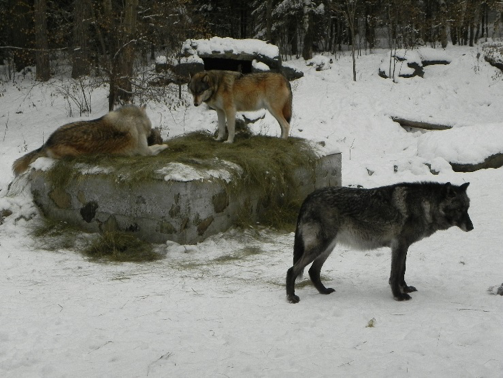Photo Above: These are three of the five wolves that live at the International Wolf Center where I do public education. The black wolf is Luna (three-year-old female), the wolf laying down is Denali (seven-year-old male), and the wolf standing up is Boltz (three-year-old male).
After I graduated from Paul Smith’s College in 2015, I became a summer educator at the International Wolf Center in Ely, Minnesota. In the fall of 2015, my boss at the International Wolf Center, Lori Schmidt, asked if I would be an Adjunct Professor at Vermilion Community College. Lori is also a professor at Vermilion. The professor I am filling in for was going on sabbatical in the spring of 2016. The provost at the college saw that I had a background in Fisheries and Wildlife, and thought that I would be a good fit. Vermilion Community College is a two-year school. Principles of Wildlife Management is a class that law enforcement, wildlife, and natural resource students must take. The student body at Vermilion is comparable to Paul Smith’s, minus the culinary major.
In many ways where I am now in Minnesota is similar to Paul Smith’s College. I had to learn new species that live in Minnesota and are not found in New York (sandhill cranes, gyrfalcons, and the 13-lined ground squirrel, among others). But the habitat surrounding this area is relatively the same as upstate New York: wetlands, pine and spruce forests, and many lakes. These habitats start to change into boreal habitat about two miles north, just like at Paul Smith’s. Weather here is also similar. We do not have a long summer, but we do have long winters. Once the snow falls, it is here to stay. The consistent snow is useful for tracking animals and doing population estimates.
When I first agreed to teach a class called Principles of Wildlife Management, I had certain ideas as to what teaching entailed. Boy was I in for a surprise. As a student you only see one aspect of teaching. I am sure most students think that the teacher shows up, lectures, and then goes home. Not many people know about the hours upon hours that a teacher spends at home preparing for each and every class, let alone the numerous hours it takes to grade every assignment. I now have a newfound respect for teachers. I never thought I would be teaching, but I have found it to be quite enjoyable. When you go into the wildlife field, you need to realize that many wildlife jobs include teaching in some aspect, whether it’s educating the public, or in a classroom.
Principles of Wildlife Management incorporates a mix of many classes that I took at Paul Smith’s College. I teach mammal ID, bird ID, habitat assessment, population ecology, population estimates, animal behaviors, differences in digestive systems, wildlife management, as well as numerous other topics. I lecture on Mondays and Fridays for an hour, and then I instruct three two-hour labs on Tuesdays. Most of my days off consist of creating lectures, worksheets, quizzes, and exams. As a teacher, you cannot leave things until the last minute. You need to think ahead and print assignments, as well as arriving early to set up classes and labs. A teacher has to be adaptable in case of cancelled classes or lectures going long. All-in-all, you must be prepared for anything.
My name is Travis Stoll and I am currently working at Vermilion Community College as an adjunct professor teaching Principles of Wildlife Management and volunteering at the International Wolf Center. I am originally from Cleveland, Ohio, but I now go wherever there are mammals that need managing. I started my career at Paul Smith’s in 2011 and graduated with a degree in Fisheries and Wildlife Sciences: Wildlife Concentration. I enjoy hiking, camping, capturing mammals, and other outdoor activities.


